
Mueller M.R. - Fundamentals of Quantum Chemistry[c] Molecular Spectroscopy and Modern Electronic Structure Computations (Kluwer, 2001)
.pdf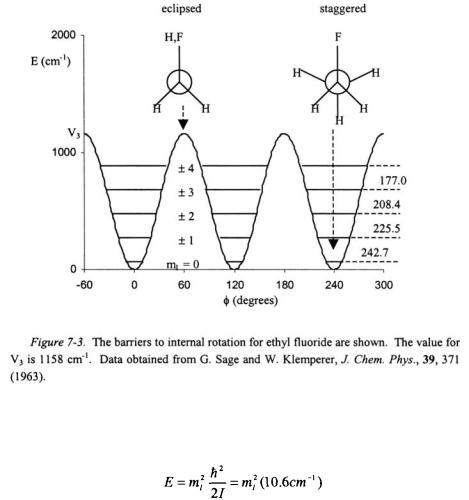
166 |
Chapter 7 |
If the methyl groups in ethane behave as free rotors, the transitions between eigenstates would be in multiples of 
The free rotor model is not adequate for most molecules as there is in general some potential barrier to internal rotation. As an example, consider ethyl fluoride. Ethyl fluoride, just like ethane, has a predominately threefold potential barrier as shown in Figure 7-3. The potential barrier can be expressed as the following function.
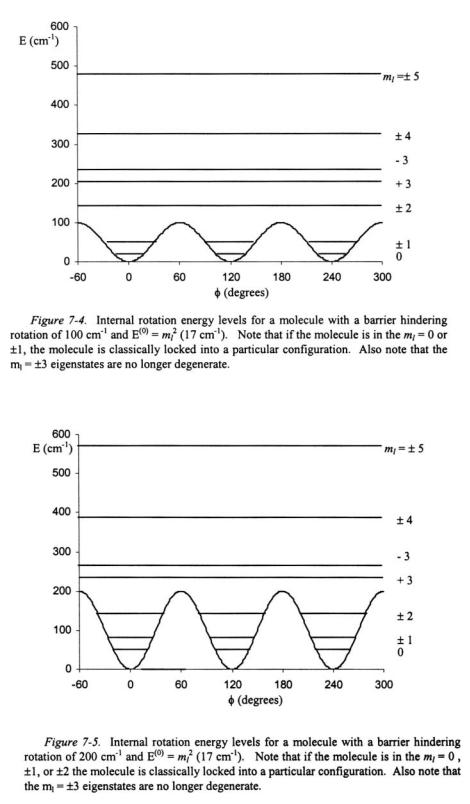
Vibrational and Rotational Spectroscopy of Polyatomic Moleculues |
167 |
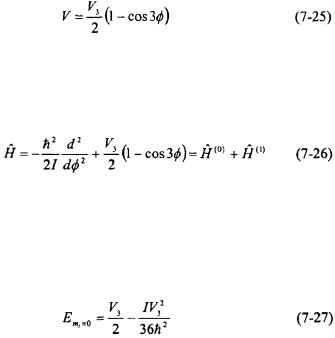
168 |
Chapter 7 |
The term  is the difference between the maxima and minima in the potential barrier. The Hamiltonian for the internal rotation is given as follows.
is the difference between the maxima and minima in the potential barrier. The Hamiltonian for the internal rotation is given as follows.
Equation 3-6 gives the zero-order energy eigenvalues. Using Perturbation theory, the energy eigenvalue for the  state including a second-order correction summed up to
state including a second-order correction summed up to  unperturbed eigenstates is given as follows.
unperturbed eigenstates is given as follows.
This analysis can be continued for other  eigenstates and what is observed is that the degeneracy is broken for some states. This is shown in Figure 7-4 and Figure 7-5 for the rotational barriers,
eigenstates and what is observed is that the degeneracy is broken for some states. This is shown in Figure 7-4 and Figure 7-5 for the rotational barriers,  of 100 and
of 100 and  respectively. As can be seen in both figures, that if a molecule is in a low rotational
respectively. As can be seen in both figures, that if a molecule is in a low rotational  eigenstate, the molecule is classically locked into a particular configuration. Quantum mechanically, however, the molecule may be able to tunnel from one configuration to another depending on the height of the barrier relative to the energy of the eigenstate for the particular configuration.
eigenstate, the molecule is classically locked into a particular configuration. Quantum mechanically, however, the molecule may be able to tunnel from one configuration to another depending on the height of the barrier relative to the energy of the eigenstate for the particular configuration.
7.3 INFRARED SPECTROSCOPY OF POLYATOMIC MOLECULES
The infrared spectra of polyatomic molecules involve vibrational transitions along with rotational transitions just like in diatomic molecules. However, especially in the case of low-resolution spectra of polyatomic molecules, the rotational fine structure is lost. The peaks in the infrared spectrum are assigned as a fundamental vibrational transition. Hence, the
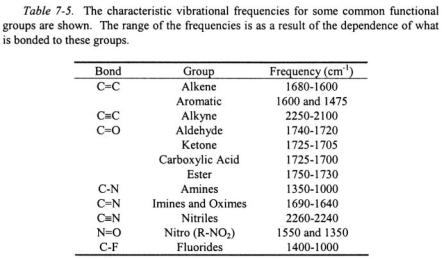
Vibrational and Rotational Spectroscopy of Polyatomic Moleculues |
169 |
low-resolution spectrum represents a non-rotating or rotationally averaged model of the polyatomic molecule. The analysis that is done in this section assumes that the molecule is non-rotating and the frequencies obtained in a spectrum correspond to a vibrational transition.
Vibrations in polyatomic molecules can be quite complicated. The motion of a pair of nuclei many times cannot be isolated from the motion of other closely surrounding nuclei in the molecule. For this reason, the characteristic absorption of a particular functional group in a molecule is assigned to a range of characteristic frequencies where it can in general be found in an infrared spectrum (a few common functional groups are shown in Table 7-5). In order to analyze the vibrations of a molecule, it is helpful to determine the number of degrees of freedom available to vibration. A molecule with N atoms has a total of 3N degrees of freedom. Three degrees of freedom are in terms of translational motion. As discussed in the previous two sections, there are 2 degrees of rotational freedom for linear molecules and 3 degrees of rotational freedom for non-linear molecules. This leaves a total of 3N - 5 degrees of freedom for linear molecules and 3N - 6 degrees of freedom for non-linear molecules that do not depend on the position or orientation of the molecule in space. The remaining 3N - 5 and 3N - 6 degrees of freedom correspond to the internal coordinates of a molecule comprised of bond lengths and angles. As an example, a gas phase water
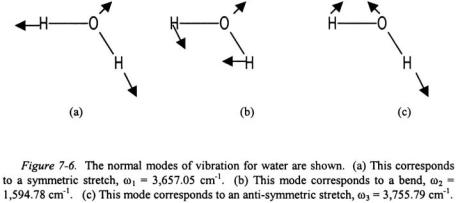
170 |
Chapter 7 |
molecule has a total of 9 degrees of freedom: 3 translational, 3 rotational (since it is non-linear), and 3 internal coordinates. The three internal coordinates correspond to the two O-H bond lengths and the bond angle.
The vibrations of a molecule set up a potential called a force field. The force field is determined for a set of internal coordinates. If the force field is completely known, then the vibrations of the molecule are known. The force field can be obtained from absorptions in infrared spectra. The simplest force field model is the harmonic oscillator, and this will be used in the analysis here of the pure vibration of polyatomic molecules.
The Hamiltonian for a harmonic potential of a polyatomic molecule can be transformed from atomic displacement coordinates of the individual nuclei to normal coordinates whereby separability of the harmonic vibrations is achieved. The normal coordinates correspond to the actual vibrational modes that the molecule will undergo.
As an example of normal coordinates, consider the normal vibrational modes of water as shown in Figure 7-6. In each vibrational mode it is important that it not reflect either translation or rotation of the molecule in space. Note that for the symmetric stretch of water, the oxygen must also move out in the opposite direction of the hydrogen atoms though its motion is much less due its greater mass or else this mode would represent translation of the entire molecule in space. In the bending mode, again an arrow is needed for the movement of the oxygen or else this mode will represent rotation or net translation of the molecule.
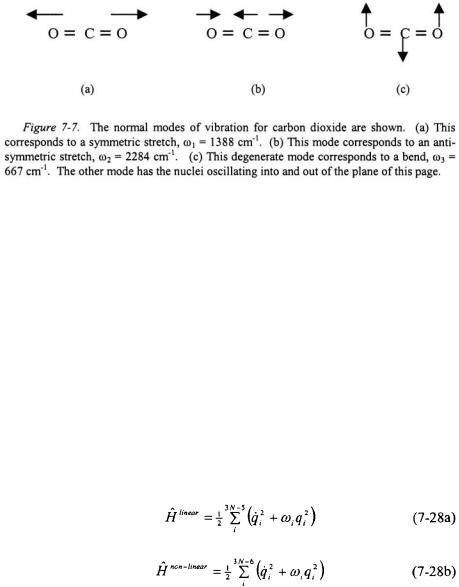
Vibrational and Rotational Spectroscopy of Polyatomic Moleculues |
171 |
As another example, the modes of vibration can be analyzed for carbon dioxide, shown in Figure 7-7. Carbon dioxide is a linear molecule with a total of 9 degrees of freedom. There are 3 degrees of freedom for translation, and since it is linear, there are 2 rotational degrees of freedom. This leaves a total of 4 vibrational modes. The independent vibrational modes consist of symmetric and anti-symmetric stretches along with two degenerate bending modes, one in plane and the other out of plane.
The position of the nuclei is written as a set  for linear molecules and
for linear molecules and  for non-linear molecules that correspond to the particular normal modes of vibration. Each vibrational mode will have an effective mass
for non-linear molecules that correspond to the particular normal modes of vibration. Each vibrational mode will have an effective mass  and effective force constant,
and effective force constant,  The Hamiltonian for the harmonic vibration of polyatomic linear and non-linear molecules is given as follows.
The Hamiltonian for the harmonic vibration of polyatomic linear and non-linear molecules is given as follows.
Each vibrational mode represented by “i” is separable resulting in multiple vibrational Shroedinger equations mathematically equivalent to that for a diatomic molecule. The eigenfunctions and the vibrational energy eigenvalues will have the same form as for a diatomic molecule.
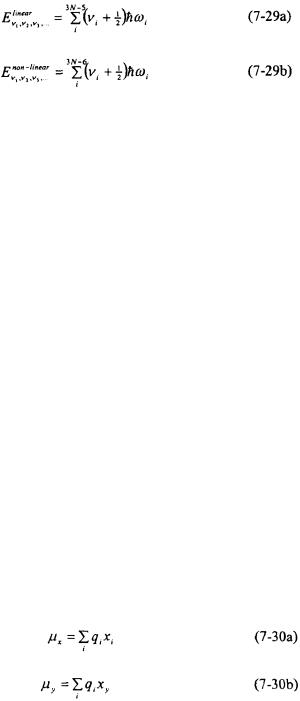
172 |
Chapter 7 |
The values of  are 0, 1, 2, 3,..., and the ground-state vibrational energy will correspond to when all
are 0, 1, 2, 3,..., and the ground-state vibrational energy will correspond to when all  ‘s are equal to zero. As an example, the harmonic vibrational energy for a water molecule is specified by three quantum numbers. The ground vibrational state for water is (0, 0, 0). An excited vibrational state for water will correspond to one or more vibrational modes at some value above zero such as (0, 1, 0) or (1, 1, 2) and so forth. Some of the low-lying harmonic vibrational levels for water are shown in Figure 7-8. Note that as the vibrational energy increases, the number of vibrational states in some small increment of energy increases. The number of states within a small increment of energy is called the density of states. The density of vibrational states for polyatomic molecules increases with increasing energy.
‘s are equal to zero. As an example, the harmonic vibrational energy for a water molecule is specified by three quantum numbers. The ground vibrational state for water is (0, 0, 0). An excited vibrational state for water will correspond to one or more vibrational modes at some value above zero such as (0, 1, 0) or (1, 1, 2) and so forth. Some of the low-lying harmonic vibrational levels for water are shown in Figure 7-8. Note that as the vibrational energy increases, the number of vibrational states in some small increment of energy increases. The number of states within a small increment of energy is called the density of states. The density of vibrational states for polyatomic molecules increases with increasing energy.
The selection rules for vibrational transitions of polyatomic molecules are the same as for diatomic molecules. The selection rule results for diatomic molecules can be applied to the harmonic model for vibrations of polyatomic molecules because the separation of variables achieved in the result states that each normal mode for vibration is regarded as a 1-dimensional oscillator. For the harmonic model, it was found that the quantum number changes by one. Also the dipole moment of the molecule must also change in the course of the transition in order for it to be an allowed transition. A molecule such as  does not have an allowed fundamental infrared transition whereas HCl does.
does not have an allowed fundamental infrared transition whereas HCl does.
In order to determine whether a particular vibrational mode of a polyatomic molecule will be active in the infrared, the molecule’s dipole must be assessed to see if it changes in a normal mode vibration. Classically the dipole moment of a molecule is determined as follows.
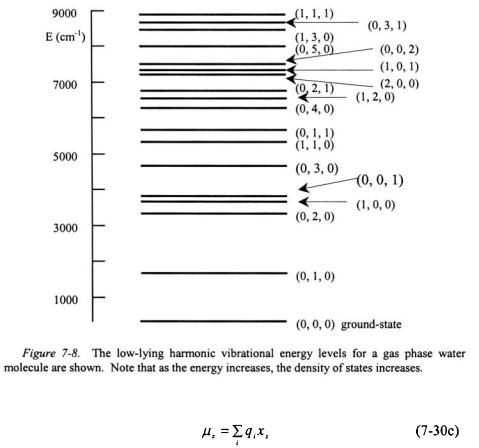
Vibrational and Rotational Spectroscopy of Polyatomic Moleculues |
173 |
The  in Equations 7-30a-c refers to the charge of the i-th particle. Following a simple scheme and Equations 7-30a-c, a qualitative determination of whether the dipole moment of a molecule is changing in the course of absorption can be made. First, all atoms are considered to have a partial charge, and atoms that are chemically equivalent are assumed to have the same charge. The displacement of the atoms in a normal mode of vibration is then considered to determine if there is a change in the dipole moment of the molecule.
in Equations 7-30a-c refers to the charge of the i-th particle. Following a simple scheme and Equations 7-30a-c, a qualitative determination of whether the dipole moment of a molecule is changing in the course of absorption can be made. First, all atoms are considered to have a partial charge, and atoms that are chemically equivalent are assumed to have the same charge. The displacement of the atoms in a normal mode of vibration is then considered to determine if there is a change in the dipole moment of the molecule.
As an example, consider carbon dioxide where the normal modes of vibration are shown in Figure 7-7. The oxygen atoms are more electronegative than the carbon atoms; hence, the oxygen atoms are assigned
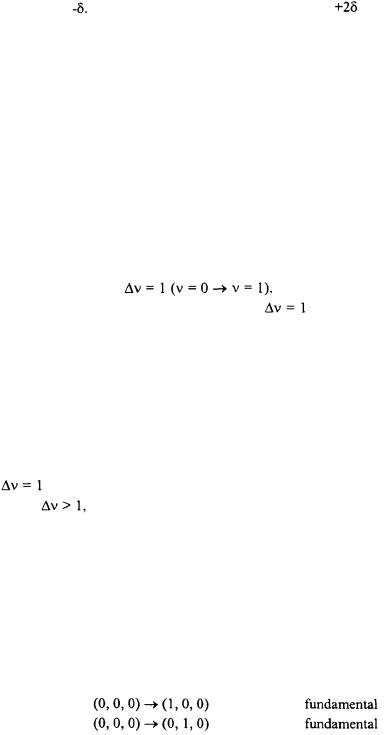
174 |
|
Chapter 7 |
a charge of |
The carbon must then have a charge of |
in order for the |
molecule to be neutral. The carbon atom is placed at the origin of the coordinate system. In the symmetric stretch mode (see Figure 7-7a), both of the oxygen atoms oscillate in-line with the carbon atom. Any change in the dipole moment of the molecule that occurs as a result of one oxygen atom oscillating is negated by the oscillation of the other oxygen atom. Consequently, the symmetric stretch of carbon dioxide will not result in a change in the dipole moment of the molecule and is a forbidden transition in infrared spectroscopy. In the asymmetric stretch (see Figure 7-7b), the oxygen atoms are oscillating counter to one another so the change in dipole moment that each oxygen atom contributes is not negated. The dipole moment of the molecule does change in this vibrational mode and it results in an allowed transition.
In the case of diatomic molecules, the strongest absorption peak in an
infrared spectrum is |
Other transitions are possible |
due to anharmonicity effects; however, the |
transition is expected to |
be the most dominant in the spectrum. For polyatomic molecules, the selection rule for harmonic vibrational transitions is also  This means that one vibrational mode undergoes a transition while the other vibrational modes do not change. Other vibrational transitions may become allowed due to anharmonicity; however, it is expected that the harmonic selection rule of
This means that one vibrational mode undergoes a transition while the other vibrational modes do not change. Other vibrational transitions may become allowed due to anharmonicity; however, it is expected that the harmonic selection rule of  while
while  for all the other modes as zero will be the strongest absorptions in the spectrum. These types of transitions, when it originates from the ground-state, are called fundamental transitions. When
for all the other modes as zero will be the strongest absorptions in the spectrum. These types of transitions, when it originates from the ground-state, are called fundamental transitions. When
|
but does not originate from the ground-state, it is called a hot band. |
When |
these transitions are called overtone transitions. When more |
than one vibrational mode undergoes a transition it is called a combination transition.
As an example, consider the possible vibrational transitions for a sample of low-density gas phase water (no hydrogen bonding) in an infrared spectrum. The vibrational quantum numbers is represented as 
where  represents the symmetric stretch,
represents the symmetric stretch,  represents the asymmetric stretch, and
represents the asymmetric stretch, and  represents the bending mode. The following list represents some possible transitions and there designation.
represents the bending mode. The following list represents some possible transitions and there designation.
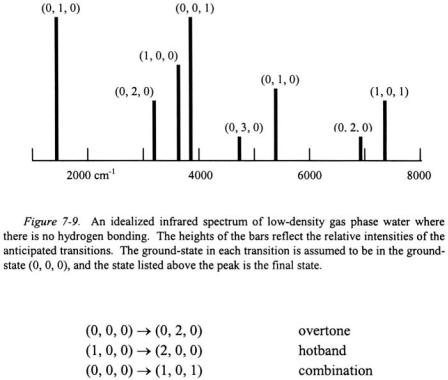
Vibrational and Rotational Spectroscopy of Polyatomic Moleculues |
175 |
An idealized infrared spectrum of water is shown in Figure 7-9. Note that the fundamental transitions are the most intense absorptions in the spectrum.
Another type of transition that may be observed in an infrared spectrum is one where the initial state is not in the ground vibrational state. This type of peak in the infrared spectrum is called a hot band. Hot bands may appear in a spectrum either very close or essentially on top of other fundamental transition peaks. As an example, the hot band transition of 
 is expected to fall in the same region as the fundamental transition of
is expected to fall in the same region as the fundamental transition of 
 The presence and identification of hot bands in an infrared
The presence and identification of hot bands in an infrared
spectrum can be determined by obtaining the spectrum at a higher temperature. The peaks of transitions involving excited initial states will grow, helping to discern these peaks from the fundamental transitions.
